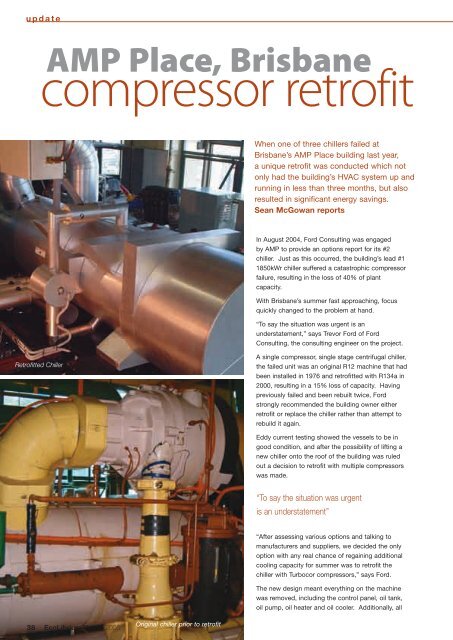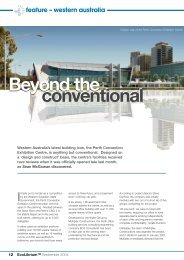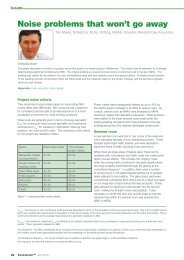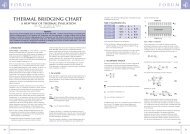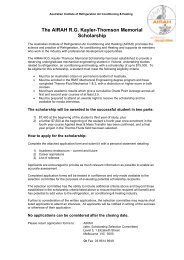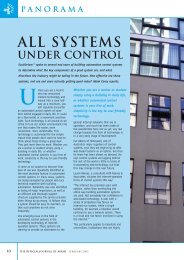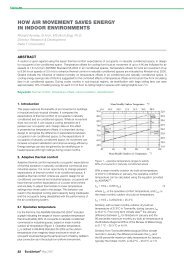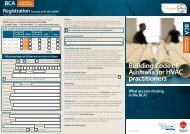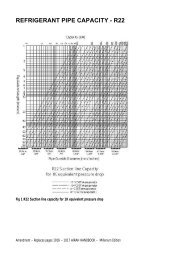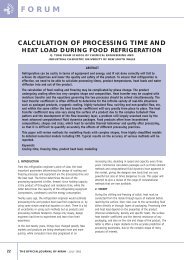AMP Place, Brisbane compressor retrofit - Australian Institute of ...
AMP Place, Brisbane compressor retrofit - Australian Institute of ...
AMP Place, Brisbane compressor retrofit - Australian Institute of ...
Create successful ePaper yourself
Turn your PDF publications into a flip-book with our unique Google optimized e-Paper software.
u p d a t e<br />
<strong>AMP</strong> <strong>Place</strong>, <strong>Brisbane</strong><br />
<strong>compressor</strong> <strong>retr<strong>of</strong>it</strong><br />
Retr<strong>of</strong>itted Chiller<br />
38 EcoLibrium July 2005<br />
Original chiller prior to <strong>retr<strong>of</strong>it</strong><br />
When one <strong>of</strong> three chillers failed at<br />
<strong>Brisbane</strong>’s <strong>AMP</strong> <strong>Place</strong> building last year,<br />
a unique <strong>retr<strong>of</strong>it</strong> was conducted which not<br />
only had the building’s HVAC system up and<br />
running in less than three months, but also<br />
resulted in significant energy savings.<br />
Sean McGowan reports<br />
In August 2004, Ford Consulting was engaged<br />
by <strong>AMP</strong> to provide an options report for its #2<br />
chiller. Just as this occurred, the building’s lead #1<br />
1850kWr chiller suffered a catastrophic <strong>compressor</strong><br />
failure, resulting in the loss <strong>of</strong> 40% <strong>of</strong> plant<br />
capacity.<br />
With <strong>Brisbane</strong>’s summer fast approaching, focus<br />
quickly changed to the problem at hand.<br />
“To say the situation was urgent is an<br />
understatement,” says Trevor Ford <strong>of</strong> Ford<br />
Consulting, the consulting engineer on the project.<br />
A single <strong>compressor</strong>, single stage centrifugal chiller,<br />
the failed unit was an original R12 machine that had<br />
been installed in 1976 and <strong>retr<strong>of</strong>it</strong>ted with R134a in<br />
2000, resulting in a 15% loss <strong>of</strong> capacity. Having<br />
previously failed and been rebuilt twice, Ford<br />
strongly recommended the building owner either<br />
<strong>retr<strong>of</strong>it</strong> or replace the chiller rather than attempt to<br />
rebuild it again.<br />
Eddy current testing showed the vessels to be in<br />
good condition, and after the possibility <strong>of</strong> lifting a<br />
new chiller onto the ro<strong>of</strong> <strong>of</strong> the building was ruled<br />
out a decision to <strong>retr<strong>of</strong>it</strong> with multiple <strong>compressor</strong>s<br />
was made.<br />
“To say the situation was urgent<br />
is an understatement”<br />
“After assessing various options and talking to<br />
manufacturers and suppliers, we decided the only<br />
option with any real chance <strong>of</strong> regaining additional<br />
cooling capacity for summer was to <strong>retr<strong>of</strong>it</strong> the<br />
chiller with Turbocor <strong>compressor</strong>s,” says Ford.<br />
The new design meant everything on the machine<br />
was removed, including the control panel, oil tank,<br />
oil pump, oil heater and oil cooler. Additionally, all
pipework was removed and the chiller<br />
vessels stripped back to bare metal<br />
before being corrosion treated.<br />
The new design by Wayne Van<br />
Aken, Queensland state manager<br />
for Airmaster Australia and Noel<br />
Courtney, Airmaster Australia managing<br />
director, included a rack system for<br />
the <strong>compressor</strong>s, a new direct digital<br />
control system with a touch screen<br />
graphical interface and electronic<br />
expansion valve evaporator control.<br />
“The new <strong>compressor</strong>s have their<br />
own inbuilt s<strong>of</strong>t starters therefore<br />
the original starting equipment was<br />
made redundant,” explains Van Aken.<br />
“The existing chiller switchboard was<br />
completely stripped out and the main<br />
starting contactors removed and<br />
reconfigured with new bus bars.”<br />
Turbocor <strong>compressor</strong>s were chosen<br />
for the project, largely due to their<br />
technologically advanced and<br />
lightweight design which allowed<br />
them to be air freighted to Australia,<br />
transported to the plant room via the<br />
existing goods lift and installed within<br />
the short timeframe.<br />
“We were impressed by the claimed<br />
energy efficiency and simplicity <strong>of</strong><br />
the <strong>compressor</strong>s - no oil, gears or<br />
conventional bearings”, says Ford.<br />
“And utilising multiple <strong>compressor</strong>s<br />
meant that in the unlikely event <strong>of</strong> a<br />
future problem the impact on overall<br />
plant capacity would be minimal”.<br />
“We were impressed by the claimed energy<br />
efficiency and simplicity <strong>of</strong> the <strong>compressor</strong>s”<br />
No oil in the refrigeration system means<br />
a gain in heat exchanger efficiencies<br />
and a general increase in chiller<br />
performance. Along with inbuilt s<strong>of</strong>t<br />
starters and variable frequency drives,<br />
the Turbocor <strong>compressor</strong>s also have an<br />
inrush current at each <strong>compressor</strong> start<br />
<strong>of</strong> less than 2 amps compared to an<br />
inrush current in excess <strong>of</strong> 2000 amps<br />
on the original <strong>compressor</strong>.<br />
“The variable speed <strong>of</strong> the <strong>compressor</strong><br />
and use <strong>of</strong> electronic expansion valves<br />
means chiller capacity is matched<br />
exactly to the building and system load<br />
requirements,” says Van Aken.<br />
“The <strong>compressor</strong> is designed<br />
specifically to operate on refrigerant<br />
134a, which is a zero ozone depleting<br />
refrigerant commercially available<br />
and addresses the issue <strong>of</strong> refrigerant<br />
upgrade which is needed on many<br />
sites.”<br />
The minimum load point for the<br />
<strong>compressor</strong>s is 60kWr, and they<br />
provide a low noise signature <strong>of</strong> less<br />
than 75dBA, meaning the <strong>retr<strong>of</strong>it</strong>ted<br />
chiller is now quieter than the chilled<br />
and condenser water pumps operating<br />
in the same plant room.<br />
“From order to the chiller first running<br />
took only two months to the day. In<br />
our experience this is a remarkable<br />
achievement for a chiller <strong>of</strong> this size<br />
and a credit to the Airmaster team,”<br />
says Ford.<br />
Operational and contributing to the<br />
building chiller plant capacity from the<br />
21st <strong>of</strong> December 2004, the project has<br />
been hailed a complete success, with<br />
the chiller operating faultlessly since<br />
practical completion.<br />
“When compared to the original<br />
Westinghouse/Email chiller the<br />
difference is stark. Full load current has<br />
reduced from 720 amps to 595 amps<br />
with capacity at 1830kWr, just 20kWr<br />
from the original R12 design. The on<br />
board data acquisition system has also<br />
recorded chiller output in excess <strong>of</strong><br />
1900kWr,” adds Van Aken.<br />
u p d a t e<br />
The original design full load COP <strong>of</strong><br />
3.87 was modeled to increase to a COP<br />
<strong>of</strong> 4.73 using the Turbocor <strong>compressor</strong><br />
- the actual recorded COP finished<br />
at 4.92.<br />
Site observations have shown a 20%<br />
energy saving at full load and a 55%<br />
energy saving at 50% <strong>of</strong> the full load<br />
capacity when compared to the original<br />
chiller, meaning the <strong>retr<strong>of</strong>it</strong> was not only<br />
able to restore 15% <strong>of</strong> lost capacity,<br />
but also significantly reduce the<br />
buildings energy costs.<br />
“Considering we are using 29-year-old<br />
vessels and associated heat transfer<br />
technology, in our opinion the result is<br />
entirely satisfactory,” says Ford.<br />
The <strong>retr<strong>of</strong>it</strong> <strong>of</strong> a second <strong>AMP</strong> <strong>Place</strong><br />
chiller is now underway.<br />
Contacts<br />
www.fordconsult.com.au<br />
www.airmaster.com.au<br />
New <strong>compressor</strong> rack<br />
“Considering we are using 29-year-old<br />
vessels the result is entirely satisfactory”<br />
EcoLibrium July 2005 39


